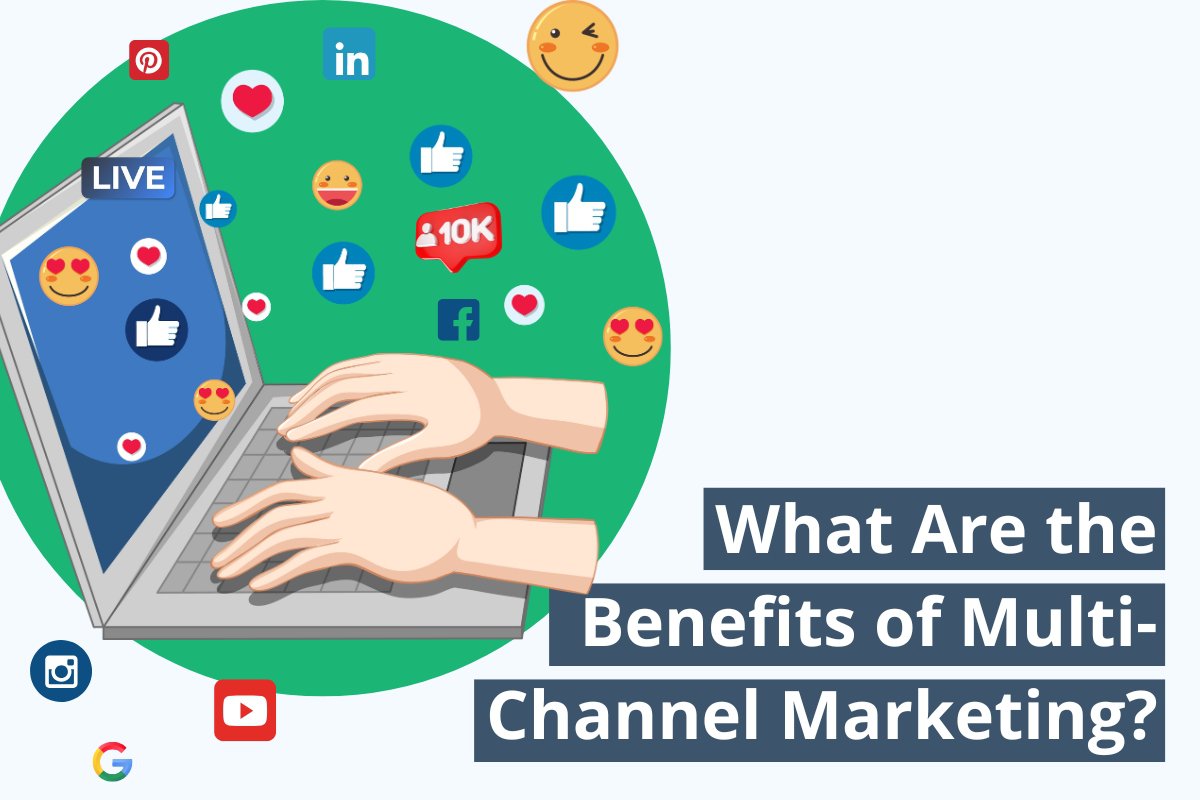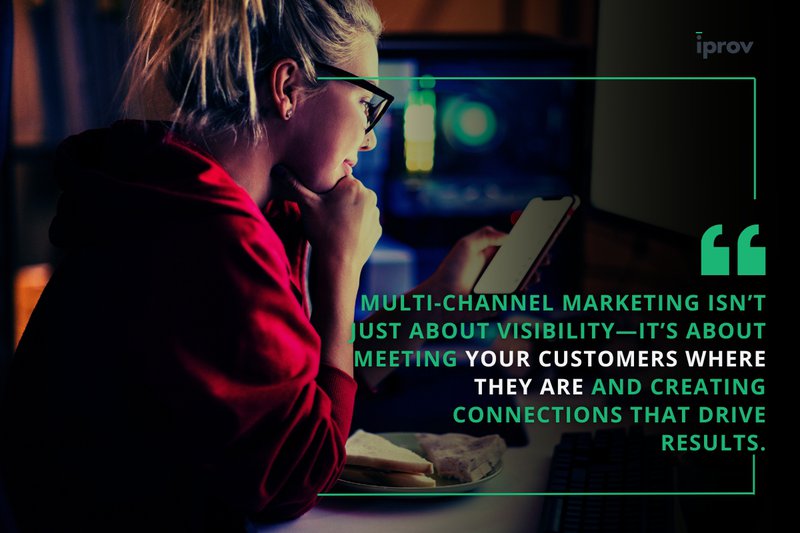
Are you reaching your customers where they actually are? In today’s crowded market, relying on just one platform is like fishing with a single hook in an ocean. Multi-channel marketing helps you engage customers across the platforms they already use. The benefits are extensive, from boosting visibility to driving higher conversions.
Key Takeaways:
- Multi-channel marketing broadens customer reach by engaging audiences across various platforms (e.g., social media, email, TV, stores).
- It increases ROI and sales by creating more touchpoints (e.g., email follow-ups after social ads) and improving conversions through analytics-based refinement.
- Personalization and consistent messaging across platforms build trust, loyalty, and seamless customer experiences.
- Tools like HubSpot, Salesforce, and analytics platforms track performance, automate tasks, and align campaigns for greater efficiency.
- Multi-channel differs from omnichannel: multi-channel platforms work independently, while omnichannel integrates them into unified campaigns.
- Success examples: Maggi paired TV with short-form social ads (+9% sales), and Gatwick Airport combined QR codes with 24-hour Twitter support.
- Cross-channel approaches bridge multi- and omnichannel by partially connecting platforms (e.g., email + SMS campaigns).
- Data-driven insights optimize strategies, adapting messaging to audience preferences for better results.

The Key Benefits of Multi-Channel Marketing
Multi-channel marketing allows businesses to connect with more customers. By using multiple platforms like social media, emails, and stores, brands can appear where their audiences are. This makes it easier for customers to interact, explore, and buy in ways that feel natural. If someone prefers shopping online but seeks support in-store, multi-channel strategies cover both options.
Customers today have high expectations. They want smooth transitions when switching between platforms. For example, if a shopping cart gets abandoned on a website, a follow-up email with the exact items and perhaps a discount can prompt the customer to return. That’s an excellent illustration of multi-channel marketing—focusing efforts on customer habits to make them feel understood.
Businesses also see greater returns with this approach. Combining ads on Instagram with TV commercials, for instance, ensures repeated visibility that sticks. Studies show people exposed to multi-channel campaigns are more likely to take action and spend. Furthermore, data collected across channels allows brands to fine-tune their strategies for higher conversions. You can learn more about optimizing strategies with these techniques.
Switching platforms also enhance loyalty. Customers engaging across more than one channel often stay longer due to feeling valued and prioritized. T
Creating an Effective Multi-Channel Marketing Campaign
Creating an effective multi-channel marketing campaign involves connecting platforms to meet goals. Firstly, focus on where your audience spends their time, craft consistent messaging, and ensure platforms work together. Here’s a roadmap for getting started.
First Steps to A Multi-Channel Strategy
Begin by identifying your audience. Outline their preferences, challenges, and habits through comprehensive buyer personas. These personas help determine the right platforms to focus on. Next, figure out how your audience progresses from awareness to purchase. While some start via social media, others may prioritize email or in-store shopping. Understanding this flow ensures your campaign supports all stages.
With your audience and journey identified, set specific goals. Whether you’re aiming to boost sales or build brand awareness, clear objectives keep your efforts sharp. Following this, create a marketing technology stack to connect data across platforms. Tools like Salesforce or HubSpot simplify customer relationships and interactions.
Maintain Consistent Messaging Across Various Channels
Consistent messaging begins with a solid brand tone and style. Whether posting on TikTok, featuring on a billboard, or crafting an email, the tone should feel familiar and recognizable. For instance, if your Instagram has a playful personality, make sure your email campaigns reflect that same vibe. Your audience should always recognize your brand.
However, format your content to fit each platform. A humorous meme might succeed on Twitter, while a detailed infographic might resonate better on LinkedIn. While the delivery varies, ensure your core message remains intact. Add calls-to-action that direct users between platforms. For example, a social ad could guide viewers to a website or mobile app, simplifying the transition.
Lastly, use a unified content calendar to coordinate timing. Proper planning keeps your campaigns connected and cohesive.
Use Analytics to Improve Multi-Channel Campaigns
Analytics are a cornerstone of effective marketing. Start by implementing tools such as Google Analytics, social media insights, or CRM dashboards to monitor performance. Use metrics like engagement, conversions, and channel effectiveness to refine strategies. For instance, if Instagram ads fail to convert, adjustments in targeting or creative content might be necessary.
Cross-channel attribution is another significant factor. It identifies which touchpoints (emails, ads, etc.) guide customers most effectively. Data from strategies like Nordstrom’s marketing approach highlight the importance of personalized timing and strategy.
Finally, learn from trends in the data. Study what resonates with your audience to enhance content, timing, and tone across all platforms. Campaigns that evolve based on feedback consistently maintain higher engagement.
Effort and strategy are necessary to succeed in multi-channel marketing, but the right tools and steps allow businesses to build campaigns that truly connect with audiences. Aligning platforms, refining the message, and leveraging data give campaigns a competitive edge.
Additional Benefits of Multi-Channel Marketing
Use Multi-Channel Marketing to Broaden Customer Reach
Multi-channel marketing enables brands to meet customers where they are, whether on email, Instagram, or TV. Each platform provides an opportunity to engage, helping businesses connect with customers with different preferences.
This approach plays to each platform’s strengths. For instance, email provides more detailed updates, while social media grabs attention quickly. Print campaigns still work for local audiences, ensuring brands leave no one out.
It’s especially effective for meeting age-group preferences. Young shoppers might love short videos, whereas older customers might be more responsive to printed coupons or TV ads. Businesses benefit from practical advice and tips for optimizing multi-channel effectiveness to reach broader audiences.
Multi-Channel Engagement for Modern Consumers
Today’s consumers use multiple devices and screens daily, making consistent marketing essential. A shopper might start researching products online, check reviews via their phone, and complete a purchase in-store. Multi-channel marketing ensures brand presence at every step, in sync with consumer behavior.
Consistency also builds trust. Aligned messaging, whether through email, social media, or physical locations, makes customers feel confident in the brand. Trust translates into loyalty, which drives repeat business.
Single-platform marketing risks losing share as consumer behavior diversifies. Multi-channel presence ensures brands stay visible during decision-making moments.
Multi-Channel Marketing and Higher Sales Conversion
Conversions often follow multiple touchpoints. A Facebook ad might get attention, but a follow-up email prompts the decision to purchase. Multi-channel campaigns multiply opportunities to engage meaningfully.
This method integrates data to enhance efficiency. Analytics highlight which channels generate the best results, allowing businesses to reallocate resources for maximum impact.
Evidence supports its value: campaigns involving three or more platforms boost ROI by up to 300%. Connecting platforms strengthen communication, improving customer experience and maximizing returns.
Comparing Multi-Channel Marketing to Other Strategies
The Gap Between Multi-Channel and Omnichannel Strategies
The primary distinction lies in execution. Multi-channel strategies use separate platforms like email, social media, or websites, without linking them into cohesive experiences. For instance, an Instagram ad campaign and an email blast might run separately under the same effort.
Omnichannel marketing integrates those platforms into one ecosystem. Clicking an ad on Instagram and finding your cart pre-filled on the brand’s website is a prime omnichannel example. The emphasis is on synchronizing touchpoints across all consumer interactions.
Cross-Channel Marketing
Cross-channel marketing blends elements of multi-channel and omnichannel approaches. It connects certain platforms without creating full integration. For example, sending a text reminder after an email promotion qualifies as cross-channel but lacks full synergy.
Cross-channel progress often lays the foundation for businesses wanting to transition into fully integrated strategies. It allows gradual testing and refinement.
Choosing the Right Approach
The choice depends on goals, resources, and needs. If you’re starting with basic resources, multi-channel marketing provides reach with less complexity. For tasks like boosting loyalty and brand depth, fully integrated omnichannel approaches shine.
Cross-channel strategies also offer flexibility, merging benefits from both setups without extensive overhauls.
Tools for Multi-Channel Marketing?
Platforms such as HubSpot and Salesforce simplify campaign organization across channels. They help streamline social media, email, and offline efforts, turning data into actionable insights. Tools like Mailchimp automate tasks such as abandoned cart follow-ups, freeing up time to focus on strategy.
Analytics Platforms
Analytics platforms like Google Analytics track engagement and identify gaps. They highlight successful channels to optimize campaigns for better returns.
Unified Tools
Unified platforms like Adobe Experience Cloud align multiple systems (e.g., POS data connecting with email campaigns). This creates seamless customer interactions.
Noteworthy Multi-Channel Successes
Maggi
Maggi condensed traditional TV ads into 8-second social media videos tailored for platforms like Facebook. The move led to sharp sales growth, with a 3.06x return on spending.
Gatwick Airport
Gatwick implemented 24-hour Twitter support and airport QR codes. These efforts boosted user satisfaction and generated widespread positive feedback.
Cross-Platform Campaigns
Combining channels eliminates disconnection and builds trust. Nielsen found that customers viewing coordinated TV and social campaigns had 12-point brand recall improvements.
Multi-channel marketing ensures broader reach, trust-building, and higher ROI—all while aligning with modern consumer needs to drive sustained growth. Learn additional steps from this guide.
Boost Your Business with Multi-Channel Marketing
Ready to expand your reach and grow your business? Multi-channel marketing empowers you to connect with your audience across multiple platforms, creating a seamless and impactful customer experience. From social media to email campaigns, this strategy enhances brand visibility and drives engagement. Discover how to optimize your marketing efforts and boost your ROI today! Visit iProv and learn actionable strategies to elevate your marketing game.
